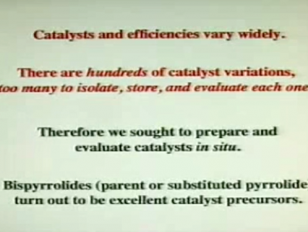Recent Advances in Olefin Metathesis Catalyzed by Molybdenum and Tungsten Alkylidene Complexes

Presenter: Richard Schrock
Published: July 2014
Age: 18-22 and upwards
Views: 1792 views
Tags: chemistry;catalysis;organic;olefin;synthesis
Type: Lectures
Source/institution: Lindau-Nobel
Watch now
In the process of preparing M(NR)(CHCMe2R’)(OR”)2 (R’ = Me or Ph) species (or analogs that contain enantiomerically pure biphenolate or binaphtholate ligands) in situ by treating M(NR)(CHCMe2R’)(pyrrolide)2 species with alcohols, we have discovered M(NR)(CHCMe2R’)(OR)(pyrrolide) (MonoAlkoxidePyrrolide or MAP) complexes (M = Mo or W)’. MAP complexes are chiral at the metal by virtue of having four different covalently bound ligands. When the alcohol is enantiomerically pure then M(NR)(CHCMe2R’)(OR*)(pyrrolide) diastereomers are formed. MAP species are remarkably active olefin metathesis catalysts (as much as 100x more active than the best bisalkoxide or diolate catalysts for a given transformation) and highly enantioselective. Catalyst loadings are typically <1%. A dramatic example of the efficacy of these new catalysts is Mo(NAr)(CHCMe2Ph)(Me2Pyr)(1) (where Ar = 2,6-diisopropylphenyl, Me2Pyr = 2,5-dimethylpyrrolide, and 1 is derived from (R)-1H where R = Si(t-Bu)Me2), which serves as an initiator for an asymmetric ring-closing of an intermediate in the enantioselective synthesis of the Aspidosperma alkaloid, quebrachamine, a reaction that yielded no product when asymmetric Mo(NR)(CHR')(diolate) catalysts were employed. Mo(NAr)(CHCMe2Ph)(Me2Pyr)(1) can be prepared in situ and is effective (95% ee) at relatively low loadings as a 7:1 mixture of diastereomers. New findings include (inter alia) the use of MAP complexes for Z- and enantioselective ring-opening/cross metathesis reactions, for the ROMP synthesis of polymers with new structures, and for Z-selective metatheses of internal olefins.



